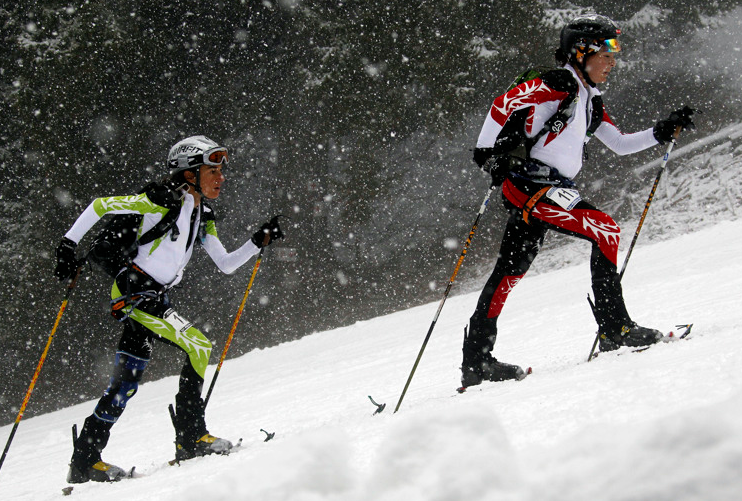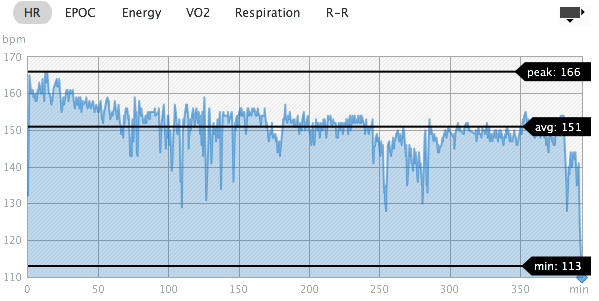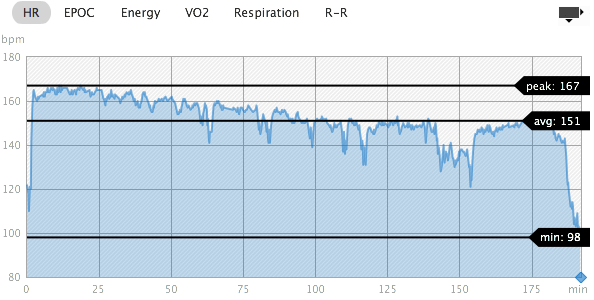 It's interesting to compare the last four race efforts via the heart rate profile for each. I don't think it's lost on any reader that longer events require slower average paces. But it is helpful and instructive to see this visually in the graphs below. Pretty cool.
It's interesting to compare the last four race efforts via the heart rate profile for each. I don't think it's lost on any reader that longer events require slower average paces. But it is helpful and instructive to see this visually in the graphs below. Pretty cool.
Jackson

Bozeman

Aspen

Powder Keg

The graphs are slightly deceptive since the scale on each Y-axis (vertical) is different. But focusing on the amount of each color is informative. Clearly, in the first and third graphs representing the longest races I spent much more time in Zone 3, sub-threshold. No way around it. In the other two races which were the typical skimo race length, most of the time was spent at threshold. Again, as it should be.
After undergoing performance testing with Dr. Max Testa not too long ago, the data generated from my lactate threshold test and VO2 max test both indicated that my "all day" pace was at a heart rate in the low 150s. This keeps me in a predominately fat burning mode allowing me to spare muscle and liver glycogen and extending the time to exhaustion. By pouring in 300 kcals/hour of carbohydrate I can extend this point a long ways. I was still charging at the end of the Aspen race, hitting 154 bpm after over 6 hours of racing. Not quite my threshold but pretty close.
Aspen Heart Rate Data

Compare this to my performance much earlier in the year at Jackson.
Jackson Heart Rate Data
 Training affects this stuff immensely. The less conditioned one is, particularly at the top end, the more glycogen one uses at a given HR and the faster these stores are exhausted. Anyone following this blog knows that I only had 7 weeks of focused preparation leading up to Jackson. Twelve would have been better. I also went out too hard for too long and it cost me dearly. Looking at the HR data you can see I could not flog it above 150 bpm at the end in spite of me charging as hard as I could.
Training affects this stuff immensely. The less conditioned one is, particularly at the top end, the more glycogen one uses at a given HR and the faster these stores are exhausted. Anyone following this blog knows that I only had 7 weeks of focused preparation leading up to Jackson. Twelve would have been better. I also went out too hard for too long and it cost me dearly. Looking at the HR data you can see I could not flog it above 150 bpm at the end in spite of me charging as hard as I could.
With a much deeper conditioning base going into Aspen I was able to go harder at the end even in a race twice as long. If you look at the zone graphs I spent way more time in both zone 3 and 4 in Aspen and was still able to go harder at the end. The one other variable I attended to at Aspen was feeding earlier. It's hard to over state the need to get the food down in the first hour of racing regardless of how hard you are going or how good you feel.
The take home here is that there is no substitute for a deep foundation. I know I've been saying this forever and I have referred readers to like-minded authors (Mark Twight) with similar experience. Although my lead up to Jackson was seriously lacking, next season will see me on the roller skis in the fall, coming to the line with the base necessary to support the race effort I seek. - Brian